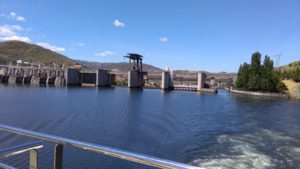There have been several earlier reviews of the Douro cruise, so we will not duplicate what has been written by others – except to say that we endorse all the comments about the many attractions of this area for a relaxing and interesting vacation. The Douro and Northern Portugal are certainly under-promoted and the country would benefit from a greater contribution to its GDP from tourism (but too many cruise ships on the Douro might spoil the serenity and overcrowd the limited number of berthing quays!)
We booked our cruise with ATP, an Australian-based travel company and, not surprisingly, the majority of the 140 passengers were Aussies enjoying an extended European holiday. But they were good company, cheerful and at least they all spoke English! ATP aims to provide top-of-the range services and these included a chauffeur-driven car from home to airport (and return). impressive and knowledgeable staff and tour guides, a well-planned and managed itinerary – including the various excursions – and good quality on board facilities. The Amavida’s cabins were cramped for space, but did have a small balcony and a 48-inch TV with a good choice of channels. The after dinner entertainment in the lounge included an enjoyable college choir on one evening and traditional Flamenco dancers on the last night. And it really was “all inclusive” – the Euros were only needed for shopping ashore!
The tour began in Porto, which is at the northern side of the Atlantic Ocean mouth of the River Douro. On the south side is Gaia, linked to Porto by bridges and combining to form Portugal’s second largest city. It is in Gaia that all the well-known port producers are based and our first day tour included an opportunity to taste the ruby, tawny and even white port wines which are famous throughout the world. Then, continuing on our 200km cruise through the countryside, we saw mile after mile of vineyards with regimental rows of vines as far as the eye could see – all waiting for the annual harvest in September.
The varied scenery included the Douro gorges and we also passed through four impressively engineered locks and river control barriers. One of them is claimed to be the world’s highest lock, lifting our boat some 35-meters in just a few minutes.
There were many opportunities to learn something of Portuguese history during excursions to Guimares, Regua and Lamego. Then from Pinhao, we were taken to Palacio de Mateus to see how the Portuguese aristocracy lives and also see the vineyards which produce the wines with the famous Mateus name (plus more tastings!) Then came a visit to the fortified, hilltop village of Figueira de Castelo Rodrigo with its spectacular views of the Douro valley.
Finally, we crossed into Spain at Vega Terron and continued our travel in coaches to the historic city of Salamanca for a few hours, en route to an overnight in Madrid before the flight home the next day.








